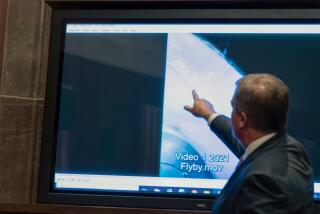What’s in a Name? Ask the Pentagon
- Share via
“Theme Castle” may sound like the latest attraction at Disneyland, but it’s the name of a multimillion-dollar, secret Air Force research program that was recently approved by a conference committee in Congress.
“Forest Green” suggests a big change in military methods since the Agent Orange program defoliated Vietnam’s jungles, but, alas, the program is reportedly an effort to monitor Soviet testing of directed-energy weapons.
And Congress has just approved another secret program called “Senior Year Activities”--surely a field trip to the Washington monument? An Air Force spokesman would not comment on that, but knowledgeable sources say the program involves the Lockheed U-2 spy jet.
The number of such top-secret programs have mushroomed in recent years, providing fertile ground for the often repressed creativity of Pentagon officers who assign names to such programs.
Funding for secret Pentagon programs has increased six-fold to $30 billion in the past five years, putting a lot of pressure on the military to develop the cagey sounding program names that will thwart Soviet spies.
Responsibility for coming up with such names is shared between program officials and a special Pentagon office that does little else but keep track of the thousands of names for Pentagon programs and activities. “Each service has a whole room full of guys whose job it is to keep track of these names,” says John Pike, an expert in secret weapons programs at the American Federation of Scientists in Washington. “They make sure the name has never been used before, that it doesn’t disclose anything about the program and that it doesn’t mean something dirty in Swahili.”
Each quarter, the Air Force publishes a pamphlet called Administrative Practices, Nicknames and Exercise Terms, which is the last word in naming programs. It runs about 75 pages.
This year’s list of secret Air Force and Navy programs include Have Trump, Constant Pisces, Clarinet Pilgrim and Constant Help (which is not a new kitchen-sink cleanser).
The military has special names for almost everything it buys and almost every activity it undertakes, such as launching a satellite or painting a lawn mower, Pike says. Hence, the code names aren’t limited to secret activities.
When the Air Force recently shipped aircraft to the Middle East, for instance, the mission was designated Paser Melon, according to Pike. Pike believes the Navy is the most creative in its naming efforts, coming up with such notables as Link Hazel, Chalk Eagle and Retract Amber.
More to Read
The biggest entertainment stories
Get our big stories about Hollywood, film, television, music, arts, culture and more right in your inbox as soon as they publish.
You may occasionally receive promotional content from the Los Angeles Times.











